“Patent pending” can mean many different things. But, once you file a patent application with the USPTO, you can start using that phrase!
I’m guessing you want to know more, right? Okay. I guess I can provide a little context for you budding inventors/entrepreneurs out there.
Let’s do a deeper dive and answer the following questions:
- How should I label my product as patent pending?
- What if I don’t have a physical product yet?
- What if my invention is a composition of matter, method, process, or software?
- Has the patent application been actually filed?
- How long can a patent be pending for?
- What kindof patent is pending?
- Is there a requirement to mark?
- Are any legal rights given while a patent is pending?
- How does a patent application lose its patent pending status?
What Does Patent Pending Mean?
It means that there is a patent application pending approval.
Done again—one-liner! Whew…that’s it! We’re done. Right? I see you’re catching on.
Look below at one of the most famous brands of all time, Rolex. On the back of one of their watches, you can see they have “Patent Pending”. That’s the bare-bones requirement, as you’ll read below. But they didn’t stop there; you can see that they described what was innovative about their pending patent by providing the title “Oyster Gas Escape Valve (Patent Pending).”
Now, who knows what an oyster gas escape valve is? No, it’s not lunch. I did a little research and found that this watch was first launched in 1967 and is a very valuable (for collectors) version of the “Sea-Dweller” (see more here).
While this watch was made in small batches in 1967, it wasn’t launched until 1971 in a more public way because they couldn’t get the patent! No patent was issued to Rolex for their “Oyster Gas Escape Valve,” as the technology for Helium Release Valves was what they needed.
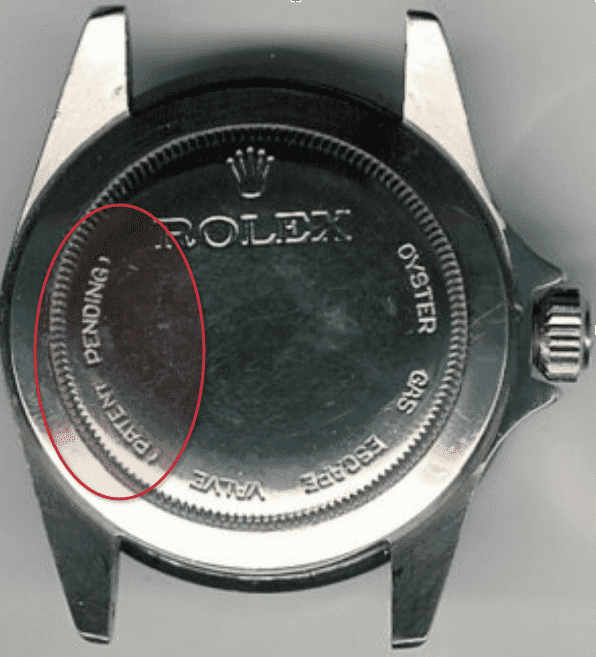
The important thing to remember is that they still were able to achieve a sense of novelty, intrigue, and ingenuity by simply labeling “patent pending” on their product.
How Should I Label My Product as Patent Pending?
There is no set way to mark goods as patent pending. There are a lot of different ways that can be effective at communicating it to consumers/public:
- “Patent Pending”
- “Patents Pending”
- “Pat. Pending”
- “Patent Pending 10/299101”
- “Patented and Patents Pending, see [URL]
- “Patent Applied, United States.”
Each different type of notice has pros/cons, but overall—as long as it’s clear what is being conveyed, and the mark is noticeable to someone looking for it, then it will qualify as notice.
There is no one way to emblazon, emboss, or stencil a patent pending mark. Nor is there a requirement for font size, font typeset, etc. The rules are subjective, but as the patent owner, you want to make it as obvious as possible without detracting too much from the design or commerciability of the product.
If you don’t have a physical product yet, and your invention is hardware-related…make one! Of course, it’s not always that easy—but you simply cannot label “patent pending” on your invention if you don’t at least have a prototype to affix the label or imprint it.
That said, if you are still in the planning stages, or if your invention would require a huge financial/time investment to build, you can create informational documents (digital or print) which will describe your invention and/or show it in diagrams/pictures. These documents should have “Patent Pending” or “Patent Applied, United States” on them as soon as you have actually filed either a provisional or non-provisional patent application.
What if your invention is a composition of matter, method, process, or software?
There are a lot of products that are too small or have physical features too delicate to display a patent pending notice. And, of course, there are many patent-eligible/pending inventions that do not have a tangible, physical embodiment such as software, methods, diagnostics, and compositions of matter.
In those cases—it would be best to place the notice on a contract or digital notice, or on a wrapper/container/enclosure.
Have I Really Filed My Patent with the USPTO?
This is probably the simplest way to express what patent pending means. If the individual or company expressing it is telling the truth, of course.
So, if an inventor has properly filed a design, utility, or plant patent application with the USPTO and has received a filing receipt, then they are officially “Patent Pending”.
What are the different types of filings? Here they are in no particular order:
- Design Patent Application (note, there is no provisional or non-provisional bifurcation)
- Utility Provisional Patent Application
- Utility Non-Provisional Patent Application
- Plant Patent Application
- Continuation/Divisional Patent Application (for those applications already pending, where additional new/novel aspects are being claimed)
So, it does come down to proving that a filing did occur. In essence, the filing receipt is what we’re hanging our hat on.
Note, that as the inventor, you may not want to publish a filing receipt, as it might tip off competitors and it is certainly WAY before the patent application gets published (which can be up to 18 months after the priority date). So, there’s no benefit for the inventor to publish.
Here is what a filing receipt looks like, with important dates highlighted in different colors below. This “official” filing receipt is sent within a couple weeks after filing. The 371(c) priority filing date, highlighted in red below, was 8/21/2014. But, the filing receipt wasn’t mailed until 9/4/2014 (see just below barcode).
This is THE most important part of the receipt, as this date will serve as the date for which the 20 years (that you get the exclusive rights to make/use/sell the invention) will start if this patent application gets granted (which it later did—see here).
Next is the green highlighted number, which is your application number. This number is “14/121,351”, and can also be shown without the slash as “14121351”, the “14/” just designates the year. So, if you wanted to be VERY thorough, you’d indicate “Patent Pending Application Number 14121351”.
You can and should also confirm that the inventors were properly identified. You can see the inventor and applicant information in the blue highlighted area.
Another key point is that this patent application, when the receipt was received, was NOT published. This means it was not findable by the general public.
Please note, in the purple highlighted area, that this is a non-provisional patent application. You can tell this because it is “claiming benefit” of an earlier filed provisional patent application “61/959,379”, and it’s also claiming the benefit of a second (which is somewhat rare) provisional “61/959,380” as well.
You can see that those two provisional patent applications were filed on 8/22/2013. So, this patent has been “PATENT PENDING” since 8/22/2013.
The non-provisional patent application was filed almost a year later (8/21/2014) and therefore may make a priority claim back to the provisional filing date.
ALSO—don’t miss the purple arrow showing when the pending patent application is forecasted to be published: 2/26/2015. This is exactly 18 months after the provisional patent application filing date (which was 8/22/2013).
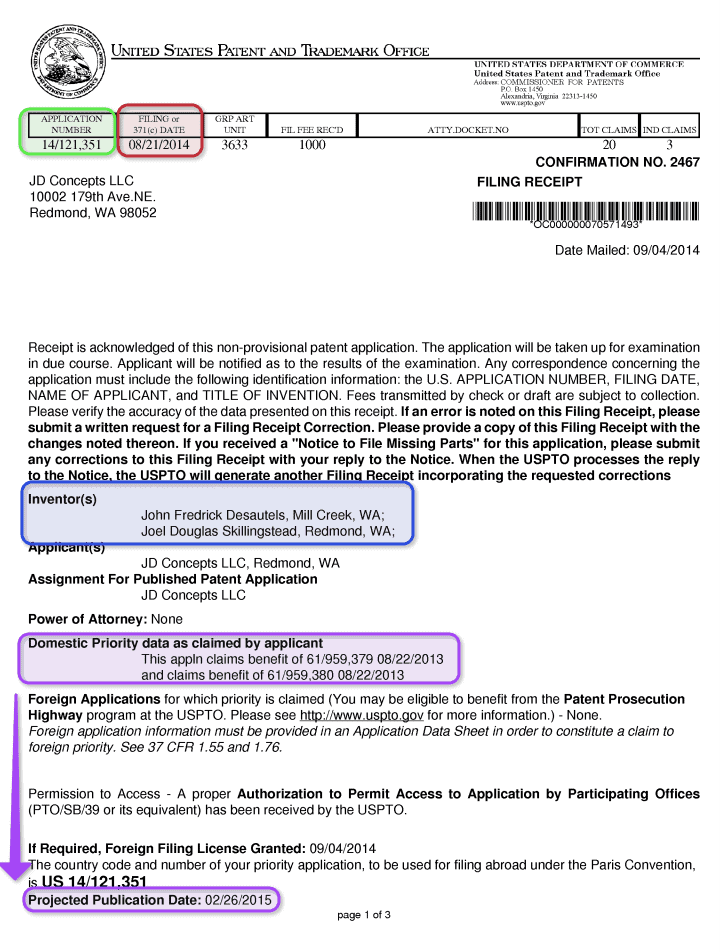
How Long Can My Patent Be “Pending”?
Alright, so someone is on stage talking in front of a startup venture capital fundraising conference, or you flip on the latest episode of Shark Tank, and you hear someone spout out, “Oh, and by the way, this product is patent pending…”
You can see the eyebrows raise, and interest in the product has increased, albeit slightly.
Most everyone knows just enough about patent law to know that when someone says “patent pending” that means that they have some rights or have at least asserted some rights and protection around the product.
Again, what does patent pending mean? It just means that a patent application was submitted. No rights, no grant, no novelty, or ownership of any kind.
But, how can you tell if they really are patent pending?
Well, as we discussed above, the patent application would need to be PUBLIC. This means that the priority date (371(c) date) of the patent application would have to be more than 18 months ago! So, if it was recently filed, you will not be able to find it.
So, you can pull the individual aside after the show, and ask them, so—where are you in the process? Did you file a provisional or non-provisional? Design? When did you file?
These are all good questions, and if not met with solid answers, you will quickly see that someone may be bluffing, be playing dumb, or honestly not understand the process.
If you were going to do some recon on the person or invention, and you were able to get the patent application number from them, visit the USPTO’s PAIR database.
You can search by a few different types of data, and the query (as of the writing of this blog is shown below). You just click on “Application Number,” enter it in one of those two formats, then click “Search.”

If you entered the information correctly, it will come back with the following screen, where you can confirm ALL the applicant/inventor data and see the priority date:
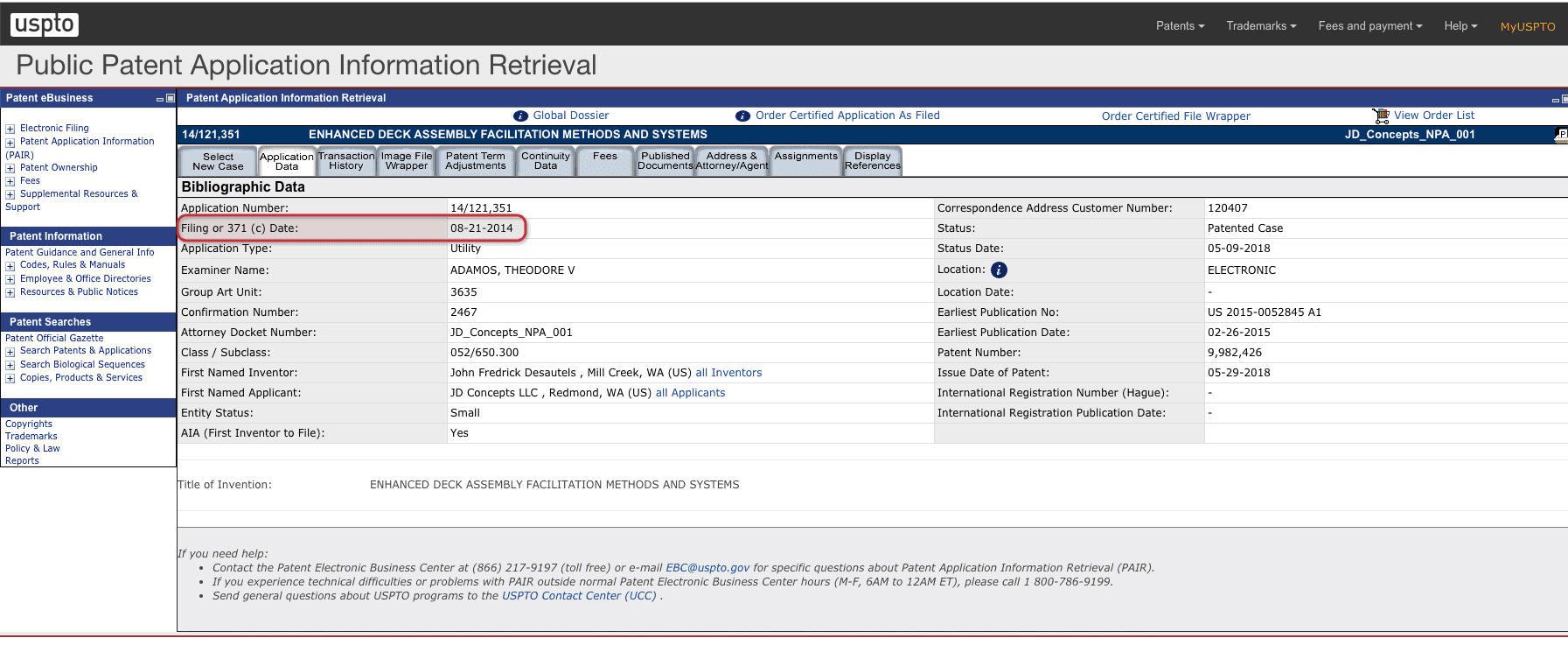
What Kind of Pending Patent Is It—Utility or Design?
If they don’t tell you that their “patent pending” is a design or utility, this is a VERY good question to ask. It should be a simple, quick answer. If it’s not, that’s reason for concern—perhaps they don’t know…
If they mention a “provisional” patent application or “provisional pending patent application,” that automatically means they have filed a UTILITY application. There are no provisional applications for design applications.
As you’ve probably read in my other articles, utility patents grant rights for FUNCTIONALITY, not design/aesthetics. Conversely, design patents grant ORNAMENTALITY, not functionality. Most tangible devices that have novel features/functions as well as looks/design should get BOTH utility and design protection to thwart would-be infringers from ripping them off.
As you saw in the above example, if you’re lucky enough to get the actual patent application number AND the patent 371(c) date (priority date) was more than 18 months ago (and therefore the application has been published), you will see plainly what “TYPE” of patent application it is (see blue highlight) from the Application Data tab in Public PAIR. It will say either “Utility”, “Design”, or “Plant”.
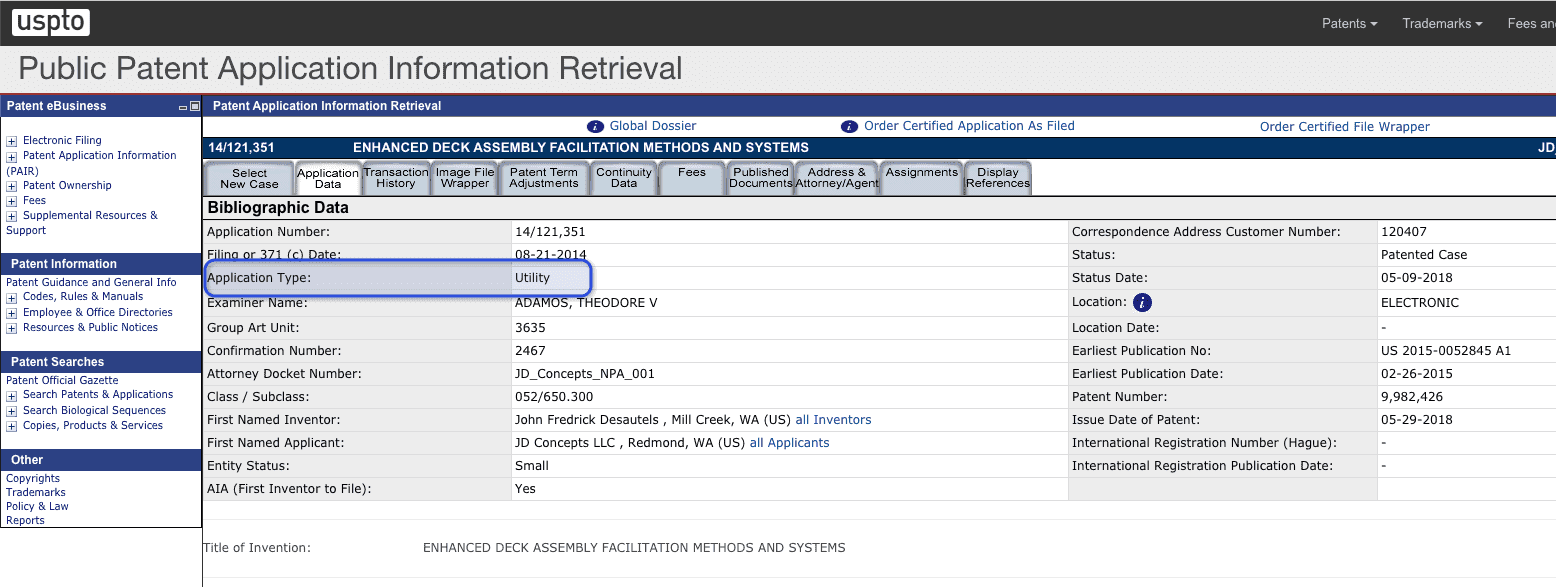
Do I Have to Use “Patent Pending” On My Product?
No, but it’s a good idea.
When an inventor of a product indicates that a product is patent pending and marks it as such, it is putting the consumers (and the public at large) on NOTICE to the fact that there are exclusive rights pending on this. This means you should not make your own similar product without permission..
While this notice is a very weak form, it can be used against an infringer later in a damages case whereby parties can be demonstrated to have purchased the product, and the “Patent Pending” notice is clearly shown.
In patent litigation, if the plaintiff (patent holder) can prove that a defendant knew about the rights (or even prospective) rights as to the invention, and disregarded that notice/knowledge, they can be held liable to pay TRIPLE damages and have to pay for the attorney’s fees of the patent holder plaintiff…so it’s a big deal.
What Rights Does a “Patent Pending” Mark Grant Me?
What does “patent pending” mean and what does it do for you are two great questions. The “patent pending” mark grants you no legal authority. No rights are bestowed on the inventor/applicant/assignee of an invention that is merely patent pending.
However, you do have the ability to put parties on notice as to your “prospective rights”, and that could be used to show knowledge/notice to support a case of infringement and even “willful infringement” down the road once the patent rights go into effect.
The scary part about the patent process is that if you, as the inventor, have decided to speak about your invention, or even publicize the invention before rights granting—you are, in effect, gambling that that patent will be granted.
Otherwise, you’ve now told the public about what you’re doing and how to do it, and if your patent rights do not get granted, you’ve created conditions to make competition easier.
Also, don’t forget about securing other forms of IP to help thwart would-be copycats. You can secure trademark and copyright protection for any business dealings or artistic creations that have been born of the new technology.
But, be warned. There are MANY license and sale deals done covering technology/patents while they are still pending. That said, the amount of money given for prospective rights is less than if the rights have been granted (e.g., 5% vs. 7% royalties). This is because the buying/licensing party is taking the risk that they cannot convince the USPTO patent examiner that a patent for the invention should be issued.
This means that licensees or buyers of certain kinds of technology can/do pay money for prospective rights (pending patents).
You should know that they will (if they are smart) hire their own patent attorney(s) to evaluate the patent application as filed for novelty, non-obviousness, validity, and enforceability. They’re not going to pay big money for just anything.
No Longer Pending?: Abandonment or Grant
There are only two outcomes of a “patent pending” mark. Either the patent gets granted, or it is “abandoned”. The important piece of this is that as soon as it reaches either of those status points, it is no longer pending.
Here are some examples of when patent applications become abandoned:
- No non-provisional application filed within 12 months of the provisional patent application.
- An office action (when an examiner rejects/objects to the application) goes unanswered within the statutory period (usually 6 months)
- A granted patent where maintenance fees are not timely paid
The first one is a BIGGIE… see the ABC flowchart (below), which clearly shows that a non-provisional application MUST be filed within 1 year (12 months, 365 days) after the provisional (see red circle highlighting “1 Year Maximum”), or else the application is declared abandoned.
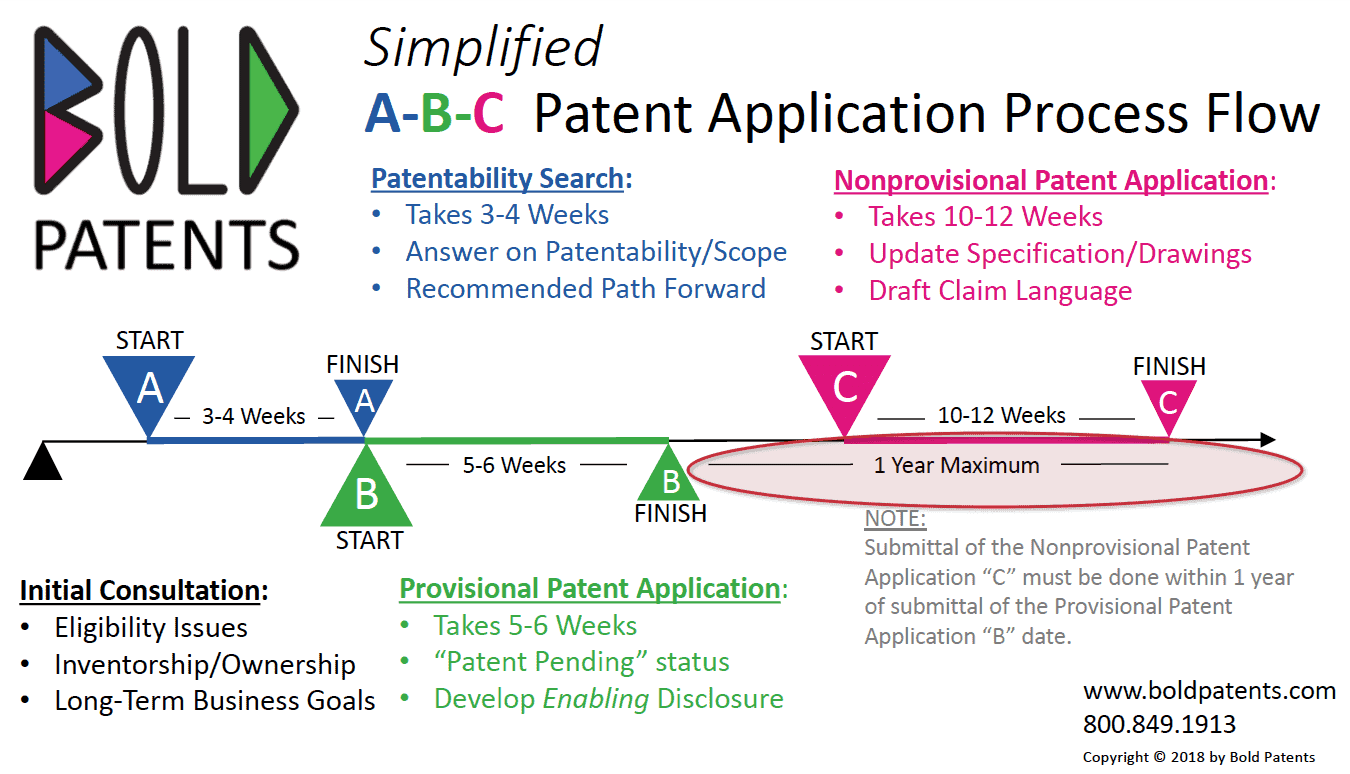
What Does Patent Pending Mean for You?
So, now we’ve talked about what “patent pending” means and how you can mark your invention. As you can tell, there are many layers to that situation than one may initially think, and it’s easiest to navigate with expert guidance from an experienced patent attorney. Contact Bold Patents to schedule a free screening today.
—
Legal Note: This blog article does not constitute legal advice. Although the article was written by a licensed USPTO patent attorney there are many factors and complexities that come into patenting an idea. We recommend you consult a lawyer if you want legal advice for your particular situation. No attorney-client or confidential relationship exists by simply reading and applying the steps stated in this blog article.

